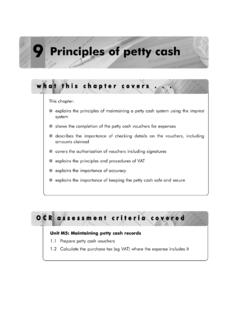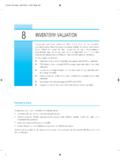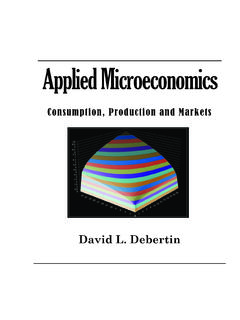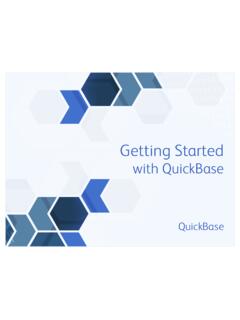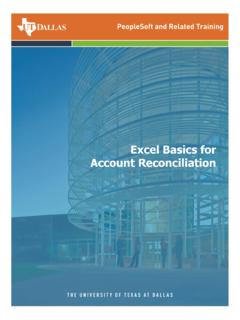Transcription of AAT Advanced Diploma Spreadsheets for Accounting
1 AAT Advanced Diploma Spreadsheets for Accounting As part of its review of the AAT L3 Advanced Diploma , AAT have amended the skills list for the Spreadsheets for Accounting unit. Spreadsheet Skills that will be no longer assessed The following Spreadsheet skills are covered in the Osborne books Spreadsheets for Accountants Tutorial book but will no longer be assessed by the AAT in the Advanced Diploma Synoptic from 1 January 2018: Adjusting contents to fit cells Aligning text Annotating charts AutoSum Borders and shading Chart production and alteration: bubble, scatter Clearing cells Consolidating data across several worksheets Date and time stamps and formats Deleting cells, rows, columns Hyperlink Histogram (knowledge only) Logical formulas.
2 Sumif Margins Moving average (knowledge only) Page breaks Page numbering Rank & percentile (knowledge only) Referencing: Circular Report: all or part of the spreadsheet by printing (hard copy), web (HTML), Word ,PDF, PowerPoint , email Trace precedents and dependents Validation circles Additional spreadsheet skills to be assessed The following three spreadsheet skills are now included in the skills list for the assessment: Roundup Rounddown Statistical technique: Forecast The next few pages cover these skills and students should ensure that they cover this material in addition to the content of the Tutorial for this unit concluding with an exercise using these skills.
3 ROUNDUP The ROUNDUP function is used to round a number in a cell UP. The formula is =ROUNDUP(number, num_digits) The ROUNDUP function has two arguments: number - the number which you wish to round up num_digits - the position of the digit to which you want to round the number, relative to the decimal point. Positive numbers will cause rounding after the decimal point, 0 will remove the decimal point and round on the last digit before the decimal point, and negative numbers will cause rounding on digits preceding the decimal point. Both arguments must be included in the function. Some simple examples are shown below: =ROUNDUP( , 1) would return =ROUNDUP( , 2) would return =ROUNDUP( , 3) would return If you enter 0 for the num_digits argument, this would to ROUNDUP to the nearest integer, for example: = ROUNDUP( , 0) would return 126 If you enter a number less than 0 for the num_digits argument, this would ROUNDUP to the nearest ten, hundred or thousand as shown below.
4 =ROUNDUP( , -1) would return 130 =ROUNDUP( , -2) would return 200 =ROUNDUP( , -3) would return 1000 ROUNDDOWN The ROUNDDOWN function is used to round a number in a cell DOWN. The formula is =ROUNDDOWN (number, num_digits) The ROUNDDOWN function has two arguments: number - the number which you wish to round down num_digits - the position of the digit to which you want to round the number relative to the decimal point. Positive numbers will cause rounding after the decimal point, 0 will remove the decimal point and round on the last digit before the decimal point, and negative numbers will cause rounding on digits preceding the decimal point.
5 Both arguments must be included. Some simple examples are shown below: =ROUNDDOWN( , 1) would return =ROUNDDOWN( , 2) would return =ROUNDDOWN( , 3) would return If you enter 0 for the num_digits argument, this would to ROUNDDOWN to the nearest integer, for example: = ROUNDDOWN( , 0) would return 125 If you enter a number less than 0 for the num_digits argument, this would ROUNDUP to the nearest ten, hundred or thousand as shown below. = ROUNDDOWN( , -1) would return 120 = ROUNDDOWN( , -2) would return 100 = ROUNDDOWN( , -3) would return 0 FORECAST As it s name suggests, the FORECAST function is used to forecasts figures ie it calculates a value based on existing values.
6 In the context of a range of x values, and the corresponding y values, the function will calculate a y-value for a specified x value using linear regression. Examples of how this function can be used would be to predict future sales values based on advertising spend, or future costs based on headcount. The formula is: =FORECAST(x, y-range, associated x-range) The FORECAST function syntax has three arguments: X The new data value for which you want to predict a value. Existing y values The range of y data values. Existing x values The range of x data values data. All arguments must be included. In the example below, the x values are the Spend, and the y values are the Sales.
7 We want to forecast what the Sales might be for the next year with a Spend of 94,067. In cell J3 we enter the formula: =FORECAST (J2, B3:I3, B2:I2) Where J2 is the required value of Spend B3:I3 are the known y values (Sales) B2:I2 are the known x values (Spend) Cell J3 displays the calculated value of Sales based on the Spend in J2. Note: All cells specified within the formula must contain numeric values, otherwise the function will return a #value! Error value. Exercise In this exercise we are going to make use of the functions explained above. 1. Download the workbook Spreadsheet supplementary exercise 2018 from the Osborne Books website. 2.
8 Open the downloaded workbook, it should appear as shown below. 3. In cell A5, enter the text Rounded Headcount. 4. Apply the ROUNDDOWN function to the Average Headcount values (cells B2 through to I2) to round to one digit after the decimal place, place the results in cells B5 through to I5. 5. Change the format of cells B5 to I5 to display just 2 decimal places. The workbook should look as follows: 6. Change the Rounded Headcount values to ROUNDOWN to no decimal places. 7. Adjust the format of cells B5 to I5 to display no decimal places. 8. In cell A6 enter the text Rounded Staff Costs. 9. Apply the ROUNDUP function to the Staff Costs (cells B3 through to I3) rounding up to the nearest hundred, place the results in cells B6 through to I6.
9 Make sure the numbers are formatted as currency with the thousand-comma separator. The workbook should look as follows: 10. Change the Rounded Staff Costs values to ROUNDUP to the nearest 10, and save your workbook. We are now going to use the FORECAST function to calculate the Staff costs for year 9 based on an expected average headcount. 11. Enter the value 56 for the expected average Headcount in Year 9 (cell J2) 12. In cell J3, use the FORECAST function to calculate (forecast) a value for Staff costs in Year 9 based on the Average Headcount and Staff Costs from the previous 8 years. 13. Change the text format for cell J3 to Italics. Your workbook should look as shown below 14.
10 In cell J6, use the FORECAST function to calculate (forecast) a value for Staff costs in Year 9 using the expected average headcount specified in cell J2, with the Rounded Headcount and Rounded Staff Costs from the previous 8 years. 15. Change the text format for cell J6 to Italics. the workbook should look as follows: Notice, because you have used rounded down staff numbers and rounded up costs, the forecast cost figure is higher, as we would expect. END


